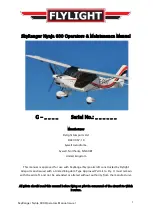
Puma 13.5
Owner’s Manual
FLYING THE PUMA
Please note the following is not meant to be an exhaustive flying manual but merely a brief note and should
be read with that in mind. It is recommended that your first flight on the Puma, is from a site you know well,
using your normal flying gear, in good weather conditions with good large landing fields. (Don't change more
than one thing at a time and be very careful on your first flight.)
Takeoff
Before takeoff make sure you've pre-flighted the glider, that you are clipped in and that you have performed a
hang check. Takeoff with the VB no more than ¼ on (unless Aerotowing). On takeoff the wings should be
held level with the nose slightly raised relative to the takeoff slope. A strong and committed takeoff run is
always recommended. Keep the angle of attack low until you are running fast. Once sufficient air speed has
been achieved increase the angle of attack gradually to takeoff. Once settled in flight, clear of the ground and
obstacles, move your hands, one at a time, to a comfortable position on the speed bar.
In Flight
The control in both pitch and roll is light and precise. Accordingly the glider should be flown with moderate
and precise inputs. The glider should not be flown too slow or in a semi-stalled condition as the roll response
becomes much slower. The glider should not be flown fast until clear of all obstacles. Coordinated turns
require a blend of roll and pitch.
Remember
: if you get into a pilot induced osscilation, (PIO) slow down. Hang gliders are generally much
more directionally stable when flying slowly. If you want to fly fast pull some VB on first. This stiffens the
handling and makes PIO much less likely. It also makes the pitch lighter (the bar easier to pull in)
The response of the glider at different VB settings and different speeds varies. It will probably take some
practise before you are able to fly the glider accurately at all speeds and VB settings. Practising this before
aerotowing the Puma 13.5 is very strongly recommended.
Stall
The Puma recovers quickly from stalls but will lose height doing so. A wing close to the stall becomes
difficult to control. For both these reasons the glider should be flown with sufficient airspeed close to the
ground, hill or any other aircraft or obstacles.
Spin
Flex wing hang gliders are generally resistant to spin. It is very unlikely that you will ever experience a spin
in normal flight (but see below
,
Flying with a wet glider). To recover from a spin pull the bar in and increase
speed BEFORE applying opposite bank.
Flying with a wet glider
DO NOT TEST YOUR NEW GLIDER IF IT IS WET. Wet gliders do not fly nearly as well as dry gliders.
This is because the water droplets on the leading edges disturb the airflow over the wing. The result is that
the glider does not perform so well and stalls at a much higher airspeed, so you will not be able to fly the
glider as slowly as if it were dry. You may also find that the glider stalls more easily, takes longer to recover
from a stall and is more prone to spinning.
If you get caught in the rain as the glider gets wetter you will notice the above effects increase. You will have
to fly faster to avoid stalling and should be especially careful when landing. We advise that, with a wet glider,
you fly with a lot of extra speed when doing any manoeuvres, near the ground or other aircraft.
Puma 13.5 hand book-Rev-02
12
Summary of Contents for PUMA 13.5
Page 1: ...PUMA 13 5...
Page 21: ...Puma 13 5 Owner s Manual Figure 4 Checking batten tension Puma 13 5 hand book Rev 02 21...
Page 38: ...Puma 13 5 Owner s Manual Section 3 Assembly Drawings Puma 13 5 hand book Rev 02 38...
Page 39: ...Puma 13 5 Owner s Manual NOSE ASSEMBLY Figure 10 Nose assembly Puma 13 5 hand book Rev 02 39...







































